Diabetes is increasingly prevalent among dogs. Identifying early symptoms like weight loss, excessive thirst, and digestive issues can significantly enhance your furry friend’s well-being.
Whether you’re newly grappling with a diabetes diagnosis or have been navigating it for a while, the journey may seem daunting. However, fret not. While diabetes isn’t curable, effective management through proper diet, exercise, and attentive care is achievable.
To enhance your dog’s health, we’ve crafted a comprehensive guide to the best diabetic dog food. From optimal foods to practical diet management tips, discover all you need to ensure your diabetic companion enjoys a fulfilling and lengthy life.
What’s the Best Diabetic Dog Food?
Diabetes in dogs isn’t uncommon, affecting roughly one in 200. When handling diabetes in our furry friends, offering a balanced diet to regulate their blood sugar is vital.
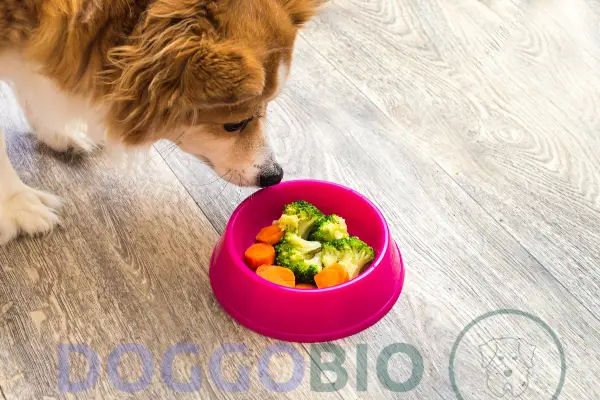
- Opt for lean proteins like chicken, turkey, or fish, alongside non-starchy vegetables such as broccoli and spinach.
- Fiber-rich foods like pumpkin and sweet potatoes can aid in controlling glucose absorption.
- Choose whole grains like brown rice or quinoa over refined grains, and consider adding healthy fats from fish or flaxseed oil.
Look at our selection of the best diabetic dog food, but remember, collaborating closely with your veterinarian is crucial to devise a tailored meal plan for your diabetic pup. They can offer insights on portion sizes and specific dietary needs based on your dog’s unique requirements.
Moreover, regularly monitoring your dog’s blood glucose levels and adjusting their diet is imperative for effective diabetes management.
Best Diabetic Dog Food
The Farmer’s Dog
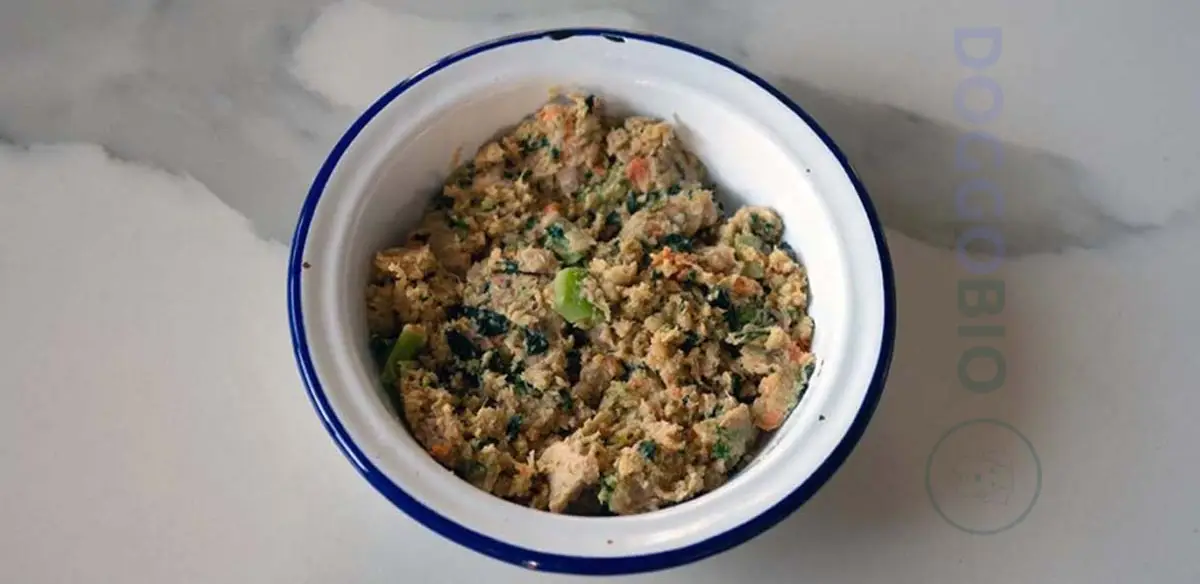
The Farmer’s Dog
The Farmer’s Dog Chicken Recipe boasts a fat-to-protein ratio of about 74%, making it a suitable option for maintaining muscle health in dogs.
Pros
High-quality Chicken as a primary protein source
Nutrient-rich ingredients, including Brussels sprouts and broccoli
Grain-free formulation suitable for all life stages
Protein-rich recipe supports muscle health
Cons
Relatively high-fat content
Potentially higher cost
Not recommended for dogs with poultry allergies
Availability may vary by region
Among our reviews of The Farmer’s Dog’s fresh product line, Chicken stands out as one of four featured recipes.
- Main Ingredients: Chicken, brussels sprouts, chicken liver, bok-choy cabbage, broccoli
- Meal Types: Grain-Free
- Design For: All Life Stages
- Ideal for: Both Puppies and Adult Dogs
The Farmer’s Dog Chicken Recipe predominantly sources its protein from Chicken. Analyzing the dry matter label, the recipe boasts 46% protein, 34% fat, and an estimated 12% carbs… resulting in a fat-to-protein ratio of approximately 74%.
One satisfied buyer remarked, “The quality is exceptional, as is the customer service.”
Raised Right Human Grade Dog Food

Raised Right
A dry matter label analysis reveals that Raised Right Turkey & Pumpkin Pate contains approximately 60.7% protein, making it a protein-rich option for maintaining muscle health in dogs.
Pros
High-quality turkey as a primary protein source
The inclusion of pumpkin for added fiber and nutrients
Grain-free formulation
High protein content supports muscle health
Cons
May be pricey
Not suitable for dogs with turkey allergies
Availability may vary by region
Some dogs may not like the Taste or texture
Turkey & Pumpkin Pate is one of 11 recipes featured in our Raised Right Fresh product line evaluation.
- Main Ingredients: Turkey thigh, pumpkin, turkey heart, turkey liver, organic spearmint.
- Meal Types: Grain-Free
- Profile: Maintenance
- Ideal for: Dogs
Raised Right Turkey & Pumpkin Pate primarily sources its meat protein from turkey. A dry matter label analysis indicates a composition of 60.7% protein, 21.4% fat, and 9.9% estimated carbs, resulting in a fat-to-protein ratio of about 35%.
Sample buyer review: “I have 2 rescues. Since I have been giving them Raised Right, they are now at a healthy weight & the intermittent GI problems that they were experiencing have completely disappeared. As stated, best dog food ever.”
Wellness CORE Grain-Free
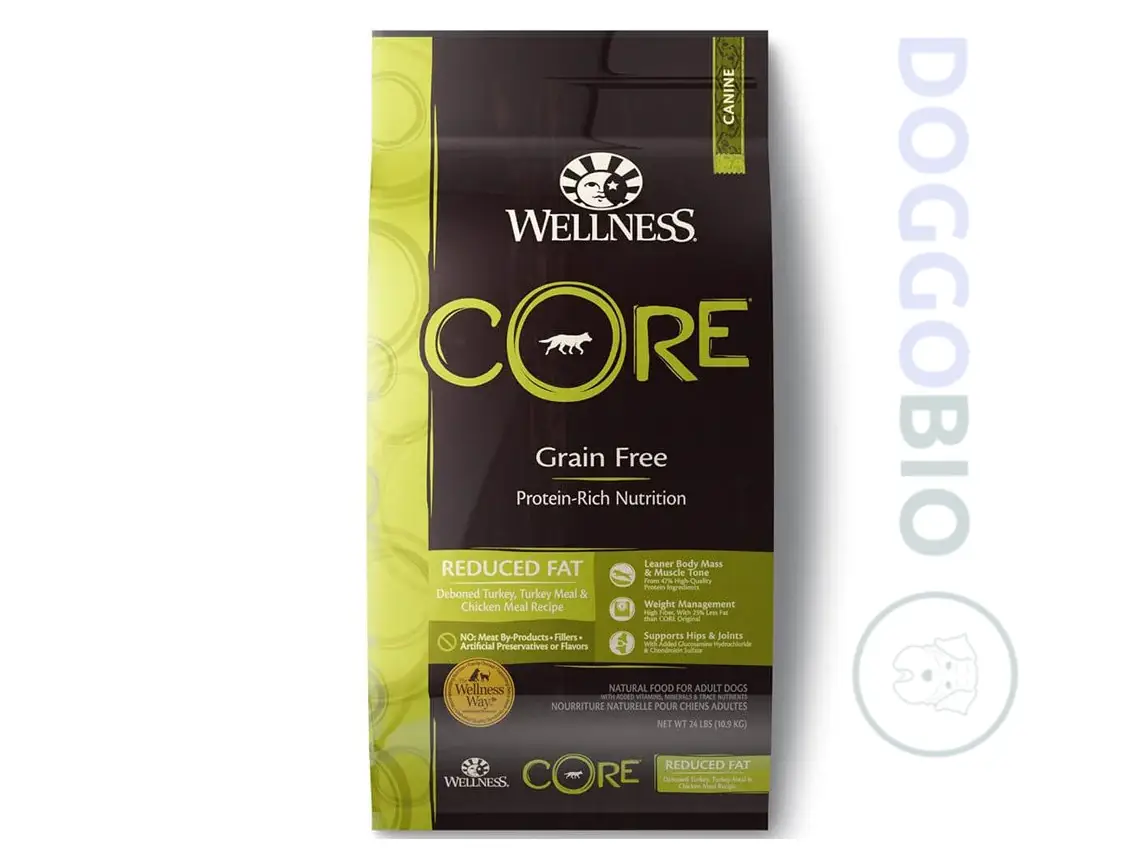
Wellness CORE
Wellness CORE Grain-Free Reduced Fat (Turkey & Chicken) is formulated with reduced fat content, making it suitable for dogs needing to manage their weight while still receiving essential nutrients.
Pros
High-quality turkey protein
Grain-free for maintenance
Ideal for weight management
Added glucosamine and chondroitin sulfate for joint health
Positive buyer testimonials
Cons
High carb content
Not suitable for poultry-sensitive dogs
Availability varies by region
Turkey & Chicken is among the 12 recipes featured in our Wellness CORE product line examination.
- Main Ingredients: Deboned turkey, turkey meal (source of glucosamine), chicken meal (chondroitin sulfate), peas, dried ground potatoes.
- Meal Types: Grain-Free
- Profile: Maintenance
- Ideal for: Dogs
Wellness CORE Grain-Free Reduced Fat (Turkey & Chicken) primarily sources meat protein from turkey. A dry matter label analysis indicates a composition of 36.7% protein, 11.1% fat, and 44.2% estimated carbs, resulting in a fat-to-protein ratio of about 30%.
Sample buyer review: “My collie was diagnosed with diabetes four years ago after a rough 6-12 months trying to get her regulated and trying several different brands of food.
We tried wellness-reduced fat and haven’t looked back. We managed to regulate her shortly after, and she’s been doing great. We also switched our malamute to it, and he had dietary issues with a sensitive stomach and would turn his nose up to different brands.
They both eat this without fail, and both have great coats and health our groomer even commented on our malamutes’ poo and how healthy it was! Sorry TMI!!! Mysti is now 13.5 years old and still doing well. Her sight did go down shortly after diagnosis, but she has full vision and nice bright eyes again!”
Taste of The Wild

Taste of The Wild
Taste of the Wild Southwest Canyon with Wild Boar offers a balanced diet with high-quality ingredients. This reflects the brand’s commitment to providing nutritious meals for dogs at all life stages.
Pros
The main protein from beef
Grain-free formulation
Positive buyer testimonials regarding Taste and excitement during mealtime
Cons
Relatively high carbohydrate content
Availability may vary by region
It may not be suitable for dogs with pea or legume sensitivities
Taste of the Wild Southwest Canyon with Wild Boar is one of 9 recipes in our Taste of the Wild product line review.
- Main Ingredients: Beef, peas, garbanzo beans, lamb meal, canola oil.
- Meal Types: Grain-Free
- Profile: Growth & maintenance
- Ideal for: Puppies & Dogs
Taste of the Wild Southwest Canyon with Wild Boar primarily sources its meat protein from beef. Dry matter label analysis reveals the recipe contains 32.2% protein, 16.7% fat, and 43.1% estimated carbs, resulting in a fat-to-protein ratio of about 52%.
Sample buyer review: “Our dogs love TOTW, and we do too! Although our dogs have their favorite flavors, they seem to like all the ones we have tried. They get excited when we bring the bag in! We as owners take great comfort in knowing that TOTW has our dogs’ health in mind when making their product.”
Merrick Pet Care
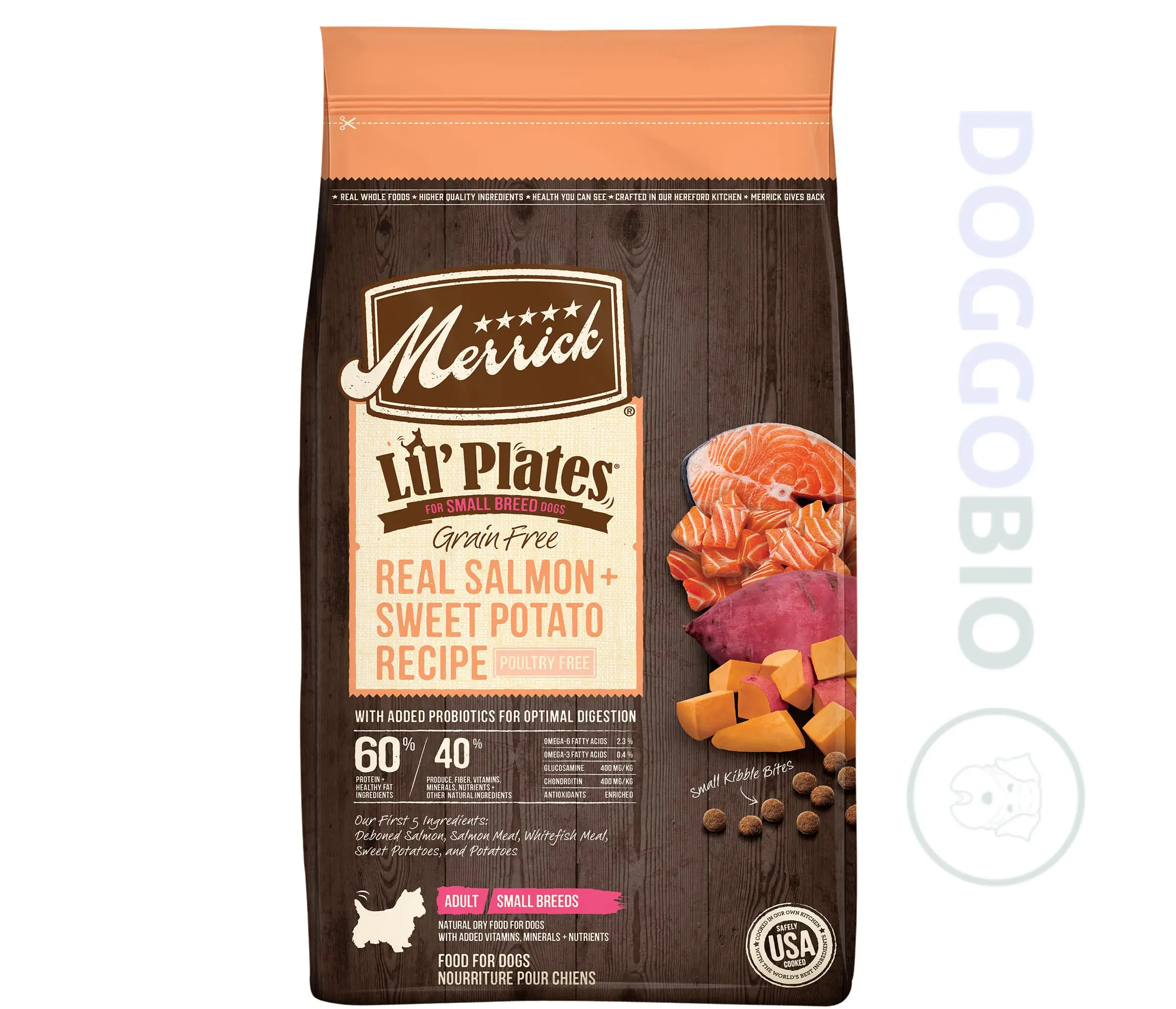
Merrick Pet Care
Merrick Grain-Free Dry Real Salmon & Sweet Potato offers a balanced diet with high-quality ingredients, supporting dogs’ overall health and well-being.
Pros
High-quality salmon is the primary protein source
Grain-free formulation
Balanced profile with added sweet potatoes for fiber and nutrients
Ideal for dogs to maintain a healthy weight
Positive buyer testimonials highlighting improved health and energy levels
Cons
Relatively high carbohydrate content
It may not be suitable for dogs with fish allergies
It may not be suitable for dogs with fish allergies
Availability may vary by region
Real Salmon & Sweet Potato is among 12 recipes in our Merrick Grain-Free Dry lineup.
- Main Ingredients: Deboned Salmon, salmon meal, whitefish meal, sweet potatoes, potatoes.
- Meal Types: Grain-Free
- Profile: Maintenance
- Ideal for: Dogs
Merrick Grain-Free Dry Real Salmon & Sweet Potato recipe relies on salmon for its protein. A dry matter label analysis indicates 38.2% protein, 15.7% fat, and 38.1% estimated carbs, resulting in a fat-to-protein ratio of about 41%.
Sample buyer review: “Merrick Grain Free Dog Food is worth it for the pup in our family!! We know we feed our dog food with great ingredients, Taste, and quality. Our dog maintains a healthy weight, active energy, and positive spirit while eating Merrick Dog Food. While she loves many varieties, her favorite flavor is Salmon and Sweet Potato.”
Farmina
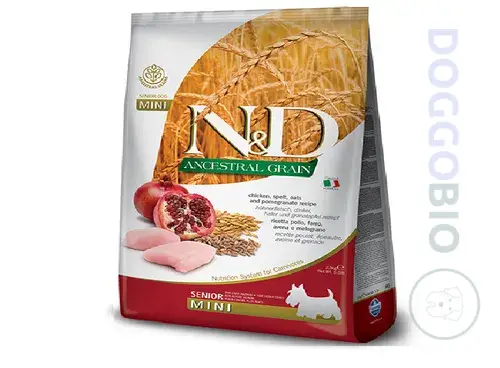
Farmina
Farmina Ancestral Grain Adult Mini Chicken & Pomegranate offers a balanced diet with high-quality ingredients, promoting dogs’ overall health and vitality.
Pros
Primary protein source from boneless Chicken
Rich in whole grains and nutritious ingredients
Positive buyer testimonials regarding coat health and overall well-being
Cons
Relatively high carbohydrate content
It may not be suitable for dogs with poultry or grain sensitivities
Availability may vary by region
Farmina Ancestral Grain Adult Mini Dry: Chicken & Pomegranate is one of 13 recipe reviews in our Farmina Ancestral Grain product line.
- Main Ingredients: Boneless Chicken, dehydrated Chicken, whole spelled, whole oats, herring
- Meal Types: Grain
- Design For: All Life Stages
- Ideal for: Puppies and Dogs
Farmina Ancestral Grain Adult Mini Chicken & Pomegranate primarily derives its meat protein from Chicken. Dry matter label analysis shows 33% protein, 19.8% fat, and 39.3% estimated carbs, resulting in a fat-to-protein ratio of about 60%.
Sample buyer review: “This is the nutritionally best food you could ever feed your pup. There is a huge diff in my poodle coat and overall health. It’s well worth the extra money if you need to feed a dry kibble but want to retain some type of raw food diet value. Highly recommended”
Rachael Ray Nutrish
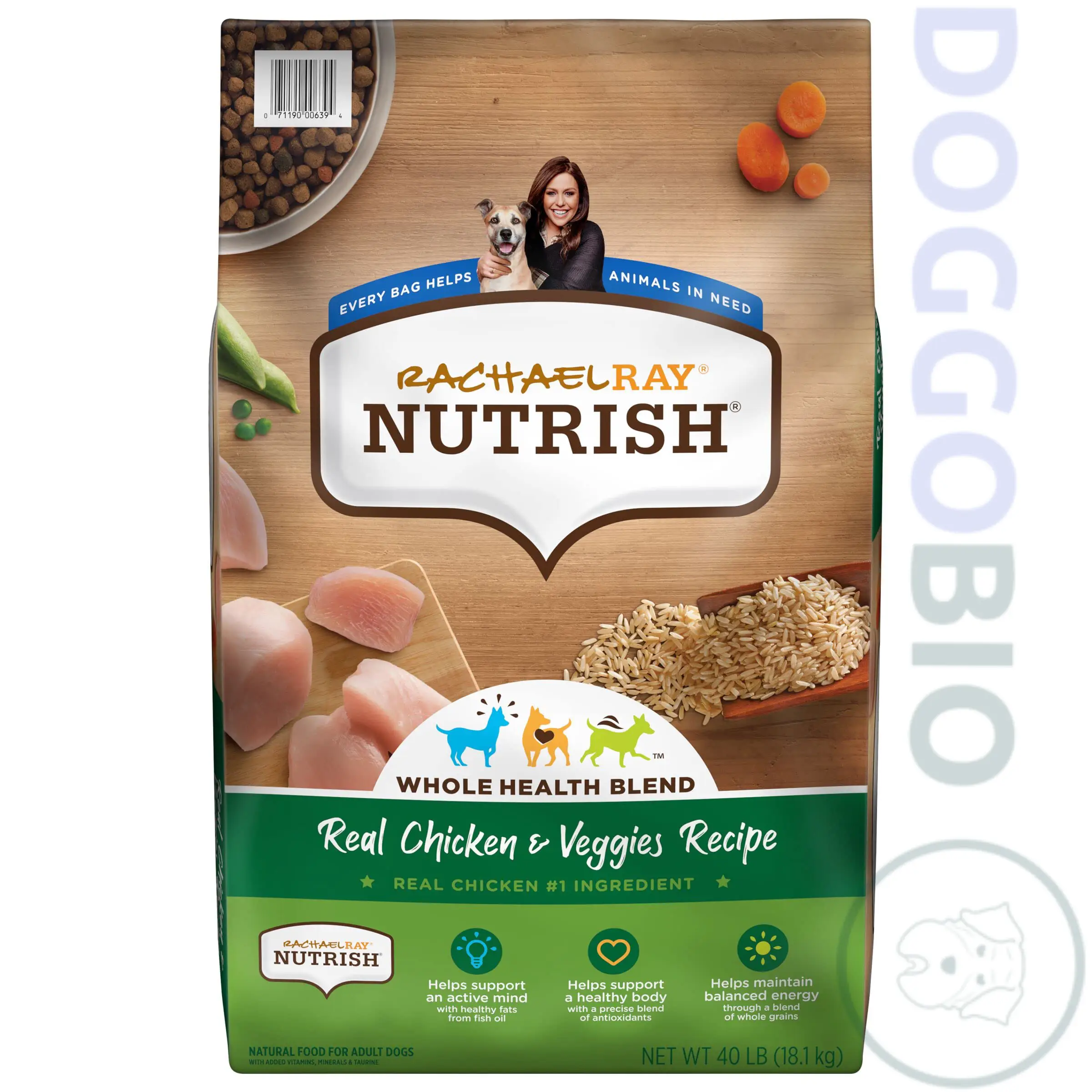
Rachael Ray Nutrish
Rachael Ray Nutrish Real Chicken & Vegetable offers an affordable option with Chicken as the primary protein source, catering to dogs’ overall health and dietary needs.
Pros
Primary protein source from Chicken
Affordable price point
Positive buyer testimonials regarding stomach tolerance and weight control
Cons
Relatively high carbohydrate content
It may not be suitable for dogs with soy or grain sensitivities
Availability may vary by region
The Real Chicken & Vegetable Dry is one of 6 recipes in our Rachael Ray Nutrish product line evaluation.
- Main Ingredients: Chicken, chicken meal, soybean meal, grain sorghum, dried peas
- Meal Types: Grain
- Design For: All Life Stages
- Ideal for: Puppies and Dogs
Rachael Ray Nutrish Real Chicken & Vegetable primarily sources its meat protein from Chicken. A dry matter label analysis indicates 29.5% protein, 15.9% fat, and 46.5% estimated carbs, resulting in a fat-to-protein ratio of about 54%.
Sample buyer review: “I’ve been feeding Rachael Ray dog food to my lab and English bulldog for the last 10 years. I’ve tried different dog foods, but this is my first choice. This seems easy on their stomach and helps me control their weight.”
What Should I Not Feed a Diabetic Dog?
Certain foods can lead to blood sugar spikes weight gain, and complicate diabetes management in dogs. Look closely at your dog’s food labels and steer clear of the following items whenever feasible.
- Semi-moist dog foods typically contain fructose, sucrose, or simple carbohydrates that can elevate blood sugar levels. Be vigilant for ingredients like sugar, corn syrup, or honey on your dog’s food label to avoid these additives.
- High-fat foods: Treats like peanut butter and milk bones are high in fat and carbs, posing a risk, especially if weight is a concern.
- Refined sugar: A strict no-no for diabetic dogs. While it may mean saying goodbye to their favorite treats, sugary snacks can trigger glucose spikes and subsequent blood sugar drops.
- Homemade fare: Although homemade food has merits, Consistency across batches can vary, and it lacks rigorous testing for nutrient interaction and absorption in commercial products. It’s advisable to opt for products crafted by companies with nutritional expertise.
- Added sweeteners: Some fiber supplements contain added sweeteners like xylitol, which can induce hypoglycemia and pose significant dangers to canines.
6 Tips for Keeping Your Dog Healthy
These 6 essential tips guide your dog’s dietary journey toward improved well-being.

1. Optimal Nutrition Provision
Diabetic dog diets should prioritize high protein, high fiber, and low carbohydrate content while avoiding sugar. Whether it’s food, treats, chews, table scraps, or medication, carefully monitoring everything your dog ingests is essential.
If your dog displays reluctance to eat, consider incorporating canned food or low-sodium chicken broth into their regular meals. This can serve as an enticing addition and ensure they receive nutrition.
2. Maintain Consistency
Alongside offering dogs the appropriate nutrients, as board-certified veterinary nutritionist Dr. Deborah Linder noted, it’s crucial to “maintain consistency to enhance diabetic control.”
Promote stable blood sugar levels in your dog by consistently feeding them the same diet. Whether meals or treats, adhering to a routine significantly aids insulin management and fosters overall health.
3. Prioritize Routine Exercise
Consistent exercise aids dogs in weight loss and blood sugar reduction. Like your dog’s feeding routine, maintaining a steady exercise regimen is pivotal for their well-being. Foster moderate activity levels and aim to sustain consistent duration and intensity levels from week to week.
4. Keep Tabs on Weight
As Dr. Linder advises, the ideal caloric intake “depends on body condition and whether the pet needs to gain or lose weight to achieve ideal body condition.”
In addition to meeting your dog’s caloric needs, regularly monitoring their weight facilitates accurate adjustments to insulin dosages and nutritional needs.
5. Monitor Glucose Levels
Consistent testing provides insight into how insulin impacts your dog. This data aids in managing blood sugar fluctuations, adjusting treatment plans, and identifying the most suitable foods for your dog. Collaborate with your dog’s veterinarian to establish an efficient testing routine and make necessary adjustments.
6. Cater to Your Dog’s Needs
Each dog is unique, so feel free to make changes if things are going well. Observe your dog’s well-being and response to their diet, monitor their exercise routine, and track their blood sugar levels.
Dr. Linder advises, “Maintain a diet journal and communicate openly with your vet,” detailing your dog’s eating habits and activity levels. This facilitates timely adjustments or reassures your dog is stable and healthy.
Frequently Asked Questions
How is diabetes diagnosed in dogs?
Diagnosing diabetes in dogs usually involves clinical assessment, physical examination, and targeted diagnostic tests. Your vet will delve into your dog’s overall health, symptoms, behavioral shifts, and any factors that might elevate diabetes risk.
Next comes a thorough physical exam, checking for signs like weight loss, dehydration, coat changes, and overall body condition. Blood and urine tests are vital for diagnosing dog diabetes. The vet will likely conduct:
- Blood glucose level: High blood glucose (hyperglycemia) points to diabetes. Sometimes, a glucose curve assesses glucose levels over time.
- Glycosuria: Glucose in urine signals excess glucose excretion, hinting at diabetes.
- Fructosamine test: This blood test gauges average blood glucose levels over two to three weeks, offering a broader view of glucose control.
What are the signs of diabetes in dogs?
Key symptoms include:
- Increased thirst (polydipsia)
- Frequent urination (polyuria)
- Increased appetite (polyphagia)
- Weight loss
- Lethargy
- Urinary tract infections
- Sweet-smelling breath
- Vision problems
- Dehydration
- Poor coat condition
What causes diabetes in dogs?
Some breeds, like poodles, beagles, and dachshunds, are more predisposed to diabetes. It can stem from an autoimmune response, where the immune system targets and damages insulin-producing cells in the pancreas, leading to reduced insulin production.
- Obesity also plays a role. Excess weight can cause insulin resistance, prompting the pancreas to produce more insulin until it can’t keep up, worsening the condition.
- Pancreatitis, or pancreatic inflammation, disrupts insulin production. Severe or recurrent pancreatitis heightens diabetes risk.
- Hormonal imbalances, like Cushing’s disease or hypothyroidism, can also impact insulin regulation, potentially leading to diabetes.
What dietary changes are necessary for diabetic dogs?
Managing diabetes in dogs requires careful dietary adjustments. The key objectives include stabilizing blood sugar, controlling weight, and ensuring balanced nutrition.
Consider these critical factors:
- Consistent Meals: Feed regularly to stabilize blood sugar.
- Optimal Food: Choose low-carb, high-fiber options.
- Portion Control: Manage sizes for weight and glucose.
- Low Glycemic Index: Select foods for slower glucose release.
- Balanced Nutrients: Ensure proteins, carbs, and fats are balanced.
- Treat Limitation: Avoid sugary treats; opt for lean options.
- Regular Feeding: Stick to a consistent schedule for insulin management.
Can I give insulin injections to my diabetic dog at home?
Yes, in most cases, administering insulin at home is feasible. Many owners effectively manage their dog’s diabetes this way. However, close collaboration with your vet is crucial to learning proper technique and ensuring the correct insulin type and dosage.
Consider these key points:
- Vet Guidance: Follow vet instructions on insulin type and dosage.
- Injection Technique: Learn proper subcutaneous technique from your vet.
- Blood Glucose Monitoring: Regularly monitor glucose levels.
- Storage and Handling: Store insulin as directed.
- Safety First: Administer injections calmly.
- Communication: Keep the vet updated on progress.
In complex cases or unstable conditions, veterinary assistance may be needed. Always consult your vet for personalized guidance on safely administering insulin at home.
How often should I check my dog’s blood sugar?
The frequency varies based on factors like diabetes stability, insulin type, treatment response, and overall health.
What are the risks of canine diabetes?
Mismanagement can lead to hypoglycemia, hyperglycemia, diabetic ketoacidosis, cataracts, urinary tract infections, pancreatitis, and organ damage. However, proper care can minimize these risks for a fulfilling life.
What is the life expectancy of a diabetic dog?
The lifespan varies based on health, treatment success, concurrent conditions, breed, and genetics. With proper care, many can lead fulfilling lives for several years. Diligent management, veterinary care, and adherence to treatment plans are vital for extending lifespan and maintaining quality of life.
Regular check-ups, blood glucose monitoring, and insulin administration (if needed) are crucial. Close collaboration with your vet ensures personalized care and the best outcome for your furry friend.
Can diabetic dog eat high-protein food?
Yes, diabetic dogs can eat high-protein food, and it can actually be beneficial for them.
High-protein diets help stabilize blood sugar levels, support weight management, and maintain lean muscle mass, all of which are important for managing diabetes. However, it’s crucial to ensure the diet is balanced and meets all nutritional needs.
Always consult with a veterinarian to develop a tailored diet plan and regularly monitor the dog’s blood sugar levels to ensure the diet is effective. For recommendations, explore more at Doggo Bio’s comprehensive guide to the best diabetic dog foods.
Conclusion
In conclusion, diabetic dog food is a vital component in caring for dogs grappling with diabetes. Specifically formulated to regulate blood sugar levels, manage weight, and bolster overall health, it serves as a linchpin in averting potential complications.
By prioritizing the dietary requirements tailored to their condition, we bolster their vitality, extend their lifespan, and fortify the bond between pet and owner. Continuous advancements in research and development remain imperative to refine the best diabetic dog food further, ensuring tailored care for each diabetic canine companion.
Please note that the information provided is for educational purposes only and does not replace professional guidance. We strongly recommend consulting with a veterinarian or pet nutrition specialist for any inquiries regarding your dog’s dietary or health needs.

Fantastic beat I would like to apprentice while you amend your web site how could i subscribe for a blog site The account helped me a acceptable deal I had been a little bit acquainted of this your broadcast offered bright clear concept
Thank you I have just been searching for information approximately this topic for a while and yours is the best I have found out so far However what in regards to the bottom line Are you certain concerning the supply
Your blog is a testament to your dedication to your craft. Your commitment to excellence is evident in every aspect of your writing. Thank you for being such a positive influence in the online community.